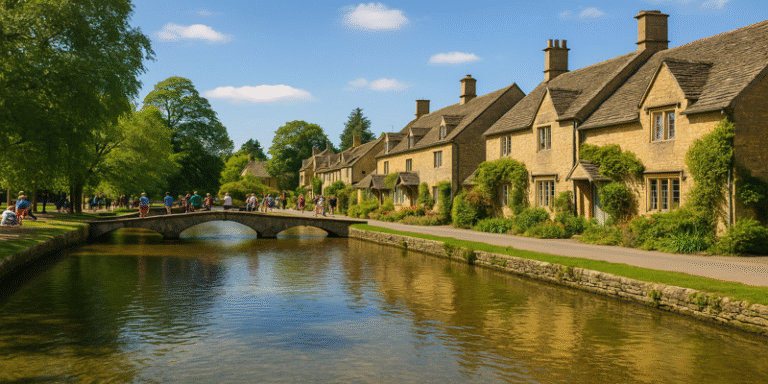Nestled in the heart of Gloucestershire, Bourton-on-the-Water is one of the most visited and celebrated villages in the Cotswolds, often nicknamed the “Venice of the Cotswolds” for its picturesque waterways and charming stone bridges. Famed for its idyllic setting, honey-coloured cottages, and vibrant tourism industry, the village has developed into a quintessential English holiday destination (Bingham, 2010). This article explores the village’s history, attractions, culture, and the challenges of tourism, offering a comprehensive view of why Bourton continues to enchant visitors from around the globe.
Historical Background
Bourton-on-the-Water’s history dates back to the Neolithic and Roman periods, with archaeological findings suggesting continuous habitation due to its location on the River Windrush (Moore, Guichard and Sanchís, 2020). Roman remains, including a villa and settlement traces, underscore the village’s historical significance in regional trade and agriculture.
The vernacular architecture of Bourton is a hallmark of its identity. Constructed primarily from Cotswold limestone, the buildings reflect centuries of rural tradition and adaptation (Moore and Tully, 2018). The conservation of these structures, governed by planning laws, ensures that modern development does not compromise the historic character of the area (Cotswold District Council, 2000).
The “Venice of the Cotswolds”
The village’s romantic nickname arises from the low, arched bridges that cross the shallow River Windrush as it winds through the centre. These waterways create a serene and picturesque atmosphere, contributing to Bourton’s fame as a must-see Cotswold destination (Turner, 2020).
Unlike many villages, Bourton’s river is shallow enough for paddling, making it especially popular with families and day-trippers during the summer months. This integration of natural and built environments has become a defining image of the Cotswolds tourist trail (Griffiths, 2017).
Attractions in Bourton-on-the-Water
Bourton’s tourism appeal lies not only in its natural beauty but also in its range of heritage attractions and family-friendly activities.
- The Model Village: Opened in 1937, this Grade II listed miniature replica of Bourton itself is constructed from local stone and showcases the craftsmanship of Cotswold builders. It represents an important piece of heritage tourism, offering visitors a unique perspective of the village (Aling, 2021).
- Birdland Park and Gardens: Established in the 1950s, Birdland houses over 500 species of birds, including flamingos, penguins, and owls. It demonstrates how the Cotswolds integrates wildlife conservation with leisure tourism (Beardmore, Jones and Biddle, 2020).
- Cotswold Motoring Museum: This attraction preserves the region’s transport history, most famously as the home of Brum, the beloved children’s television car.
- Dragonfly Maze and Model Railway Exhibition: These attractions contribute to the village’s image as a family-friendly destination, ensuring appeal across multiple age groups (Brace, 2000).
Tourism, Economy, and Cultural Heritage
Bourton-on-the-Water’s reliance on heritage and rural tourism has shaped its economy. Visitor numbers swell dramatically in peak seasons, supporting a large number of hospitality businesses, including tea rooms, pubs, and bed-and-breakfast establishments (White, 2010).
The Cotswolds brand—centred on ideas of rural beauty, tranquillity, and Englishness—has been crucial in marketing destinations like Bourton (Kirshenblatt-Gimblett, 1996). However, this image has also been criticised for creating a stage-set atmosphere, prioritising aesthetics over the realities of rural life (Griffiths, 2017).
Archaeological landscapes such as Salmonsbury Camp, a nearby Iron Age oppidum, receive far fewer visitors, overshadowed by the village’s picturesque centre. This reflects the tendency of tourism to concentrate on the visual charm rather than deeper historical narratives (Moore, Guichard and Sanchís, 2020).
Managing Tourism Pressures
Like many popular villages, Bourton faces the challenge of over-tourism. Large influxes of visitors, sometimes overwhelming the village’s narrow streets and limited infrastructure, create tensions between residents and tourists (Tully, 2016).
Conservation policies, such as the Bourton-on-the-Water Conservation Area Statement (Cotswold District Council, 2000), emphasise maintaining architectural integrity and protecting green spaces. However, balancing economic benefits with community well-being remains a key challenge.
The issue is compounded by the rise of day-tripping tourism, where thousands visit for a few hours without contributing significantly to local spending. Research by Moore and Tully (2018) highlights the importance of integrating stakeholder values into cultural landscape management, ensuring that the village remains liveable for residents while continuing to thrive as a tourist hotspot.
Seasonal Events and Cultural Life
Events such as the Bourton Football in the River match, held annually on August Bank Holiday, embody the village’s quirky traditions. Played in the shallow waters of the River Windrush, it attracts large crowds and symbolises the blending of local culture with tourism appeal (Dunn, 2017).
The village also hosts craft fairs, food festivals, and art exhibitions, which provide opportunities for local artisans and producers to engage with the tourism economy, reflecting wider sustainable tourism practices (Ashley, 2011).
Bourton in the Wider Cotswold Context
Bourton-on-the-Water represents the archetype of Cotswold tourism. It sits alongside other iconic destinations such as Bibury and Stow-on-the-Wold, yet its combination of waterways, attractions, and accessibility makes it uniquely popular (Bingham, 2010; Schultz, 2012).
Situated near the Fosse Way, an ancient Roman road, Bourton also acts as a gateway to exploring Gloucestershire’s rural heritage (MacLeod, 2013). Its position ensures that it remains central to coach tours and day trips across the Cotswolds.
Bourton-on-the-Water continues to thrive as a symbol of Cotswold beauty, offering a unique mix of history, architecture, and family attractions. Its branding as the “Venice of the Cotswolds” has cemented its status as a must-see destination for both domestic and international tourists.
However, its popularity presents challenges, particularly in terms of sustainable tourism management, resident satisfaction, and preservation of its authentic cultural landscape. With careful planning, inclusive governance, and continued emphasis on heritage conservation, Bourton will remain a shining jewel in the Cotswolds crown for generations to come.
References
Aling, M. (2021). Backgarden worldbuilding: the architecture of the model village. Architectural Design, 91(5), pp.110–117.
Ashley, P. (2011). Cross country: English buildings and landscape from countryside to coast. London: Frances Lincoln.
Beardmore, A., Jones, M. and Biddle, M. (2020). Strengthening Local Communities Programme Evaluation: Health Connect Project, Bourton-on-the-Water. University of the West of England.
Bingham, J. (2010). The Cotswolds: A Cultural History. Oxford: Oxford University Press.
Brace, C. (2000). A pleasure ground for the noisy herds? Incompatible encounters with the Cotswolds and England, 1900–1950. Rural History, 11(1), pp.77–96.
Cotswold District Council (2000). Bourton-on-the-Water Conservation Area Statement. Available at: https://www.bourtononthewater-pc.gov.uk [Accessed 21 Aug. 2025].
Dunn, T. (2017). Model Villages. Stroud: Amberley Publishing.
Griffiths, C. (2017). The Future of Village Life: welfare, planning and the role of government in rural Britain between the wars. In: Governing the Rural in Interwar Europe. Abingdon: Routledge.
Kirshenblatt-Gimblett, B. (1996). Tourism and Heritage. University of Pennsylvania Press.
MacLeod, J. (2013). Batsford’s Walking Guides: The Cotswolds: 20 Country Walks for All the Family. London: Batsford.
Moore, T. and Tully, G. (2018). Connecting landscapes: examining and enhancing the relationship between stakeholder values and cultural landscape management in England. Landscape Research, 43(7), pp.922–934.
Moore, T., Guichard, V. and Sanchís, J.Á. (2020). The place of archaeology in integrated cultural landscape management: A case study comparing landscapes with Iron Age oppida. Journal of European Landscapes, 1(1), pp.29–45.
Schultz, P. (2012). 1,000 Places to See Before You Die: A Traveller’s Life List. New York: Workman.
Turner, M. (2020). 50 Gems of Gloucestershire: The History & Heritage of the Most Iconic Places. Stroud: Amberley Publishing.
White, D. (2010). Haunted Cotswolds. Stroud: The History Press.









